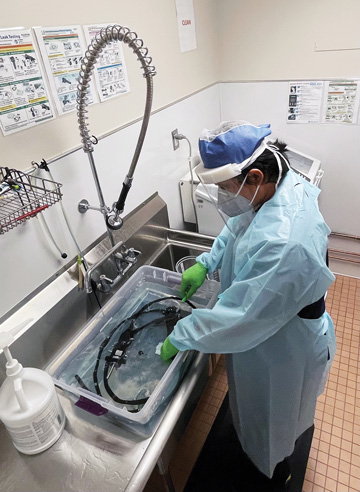• Proper storage. After scopes are removed from the automated endoscope reprocessor (AER), thoroughly rinsed and dried, they must be stored in drying cabinets with circulating forced air to prevent contamination and protect the devices
themselves. “There are commercially available endoscope drying cabinets or cabinets with HEPA filters that circulate air around the scopes,” says Ms. Ynchausti. “Then, tags are attached that show information about the date
and time the scope was last reprocessed and by whom to make it easy for the next user to determine whether a particular endoscope is ready for use or whether it needs to be reprocessed again.”
• Specialized training. Precleaning at the bedside and manual cleaning in the reprocessing area are the two areas where you see the most mistakes, according to Dr. Knight. “Manual cleaning is a major area where mistakes come
into play because there’s often a variance in the critical steps reprocessing technicians take,” he says. “Staff with little experience also see how something is done once and then have to jump in and do it themselves.”
To remedy this problem, he recommends a thorough onboarding of reprocessing technicians as well as requiring the techs to get their Certified Endoscope Reprocessor (CER) certification. “These certifications guarantee that a lot of time and
effort goes into learning the process and understanding the ‘why’ behind the various steps of endoscope care,” says Dr. Knight. He says you can avoid problematic variations in technique simply by requiring staff to follow
the scope manufacturer’s IFU and providing periodic education to make sure every team member is doing it the right way.
Ms. Ynchausti recommends leaning on a variety of experts to help in this area. “Endoscope service representatives who are up to date on the latest compliance protocols and guidelines will generally provide free or low-cost in-service training
on their IFU,” she says. Another option, according to Ms. Ynchausti, is reaching out to regulatory surveyors. “They want to help facilities uphold safety and quality standards and can point you in the right direction with respect
to endoscope reprocessing,” she says.
Dr. Knight agrees with the benefits of reaching out to surveyors. “Conduct a mock survey and have surveyors take a hard look at your processes,” he says. “Their feedback might be tough to hear, but ultimately you’re going
to come away with a corrective action plan to address your variations — and change your culture.”
• Spot checks. Of course, even with properly trained and certified technicians on staff, you still need to regularly audit your processes and monitor technicians closely to ensure that variations or personal preferences don’t
seep into the workflow. To that end, Ms. Ynchausti recommends using an easy-to-follow checklist to guide your spot checks and random audits. “My center uses the HICPAC Sample Audit Tool for Flexible Endoscope Reprocessing, which is available
for free on the CDC’s website,” she says. (Access the tool here: osmag.net/auditIC.)
Even with the most methodical, uniform manual cleaning processes in place, you’ll still need to verify that scopes are clean — and that’s where rapid adenosine triphosphate protein (ATP) testing, which uncovers whether live bacteria
is still present, can pay dividends. “ATP testing is a best practice that should be employed by facilities to ensure scopes have been properly cleaned,” says Dr. Knight. “If a scope doesn’t pass, you reclean and retest
it before moving on to the next step in the process.”
.svg?sfvrsn=be606e78_3)

.svg?sfvrsn=56b2f850_5)